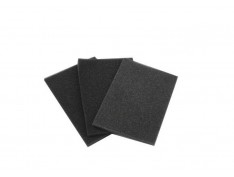Product Categories
Technology news
Component-Level ESD Rating
Views: 1689 Jun 26 , 2018
The ESD protection design for an IC package
is known to be critical for safe production and handling. It is commonly
understood and accepted that this protection design is expected to meet or
exceed the required ESD specification when these ICs are handled in an ESD-safe
area, also known as ESD Protected Area (EPA) [1]. The ESD protection strategy
for ICs involves discharging of the ESD events that might occur on any pin of
the package that is...
Read More
What's the Difference Between Conductive Foam and Anti Static Fo
Views: 2059 Mar 08 , 2018
Sinkery foam is specially used to protect electronic parts or static sensitive components in a variety of applications. Because of different requirements to the different products, customers choose different type foam. Such conductive foam type, anti static foam type and static dissipative foam types. Let me introduce the Conductive Foam vs Anti static foam.
what is conductive foam
Conductive foam is a polyethylene foam...
Read More
What is The antistatic EVA
Views: 1659 Feb 24 , 2018
The antistatic EVA is closed-cell foam. In the forming process of EVA foam, conductive carbon powder filler is added and molded and foamed to form the EVA foam.
Characteristics
1. excellent anti-static performance: anti-static timeliness for permanent anti - static, not affected by environmental dry humidity; 2. excellent cushioning performance: independent and fine closed cells; 3. excellent conductivity: electrostatic index value 104 -...
Read More
Usages of conductive fabric
Views: 1670 Feb 07 , 2018
Conductive cloth can be used in electronic, electromagnetic and other radiation work of professional shielding overalls, shielding room special shielding cloth; It industry shielding special cloth, current popular touch screen gloves, anti-radiation curtains, etc. Conductive cloth pad is made of high conductivity and corrosion resistance of conductive cloth, wrapped in high elastic pu foam, after precision processing. The conductive cloth pad has good...
Read More
What hazards can the electrostatic discharge ESD cause?
Views: 1483 Jan 31 , 2018
ESD
electrostatic discharge (ESD), the biggest and most common hazard is in the
electronics industry, and all high precision technology industries based on
electronic devices. Static electricity can inadvertently expensive electronic
device breakdown, the damage caused by dysfunction of electronics and
components, especially semiconductor integrated components now increasingly
large scale, integrated voltage is lower and lower, the greater the...
Read More
What is ESD?
Views: 1567 Jan 26 , 2018
Electrostatic Discharge is a high
voltage event from the release of electrical energy caused by static
electricity or electrostatic induction. ESD can cause permanent damage to
electronics and integrated circuits.
Read More
Two Causes of ESD
Views: 1751 Jan 25 , 2018
Static
electricity is One of the causes of ESD events. Static electricity is
often generated through tribocharging, the separation of electric charges that
occurs when two materials are brought into contact and then separated. Examples
of tribocharging include walking on a rug, rubbing a plastic comb against dry
hair, rubbing a balloon against a sweater, ascending from a fabric car seat, or
removing some types of plastic packaging. In all...
Read More
What is Electrostatic discharge?
Views: 1615 Jan 24 , 2018
Electrostatic
discharge, which
shorted for ESD, is the sudden flow of electricity between two
electrically charged objects caused by contact, an electrical short, or
dielectric breakdown. A buildup of static electricity can be caused by
tribocharging or by electrostatic induction. The ESD occurs when
differently-charged objects are brought close together or when the dielectric
between them breaks down, often creating a visible...
Read More
How to prevent ESD damage in electronics
Views: 1755 Jan 22 , 2018
Prevention
of ESD bases on Electrostatic Protective Area (EPA). EPA can be a small working
station or a large manufacturing area. The main principle of an EPA is that
there are no highly charging materials in the vicinity of ESD sensitive
electronics, all conductive materials are grounded, workers are grounded, and
charge build-up on ESD sensitive electronics is prevented. International
standards are used to define typical EPA and can be found for...
Read More
Markets and Industries Using Conductive Foams
Views: 1789 Jan 19 , 2018
Handheld
Electronics
Portable data
acquisition & ruggedized devices
Medical devices
Displays (LCD
and PDP)
Antennas and telecommunications
LED lighting
Asset
tracking
Industrial
equipment
Read More
Common Applications for Electrically Conductive Foam
Views: 1711 Jan 17 , 2018
Electrical
contacts for PCBs
Electrical
coupling in handheld electronics
Sensors
and electrical connectors
EMI
shielding for enclosures
LCD
gaskets
ESD
sensitive manufacturing
Dust
sealing
Shock
and vibration absorption
Read More
Three types of foam for the five following broad usage:
Views: 1658 Jan 16 , 2018
1. Bare populated boards with no battery. Single-use: Anti-static (pink)
inside of a silver conductive bag. Multi-use: Conductive (black) foam.
Alternately you can use static dissipative (black) foam inside of a conductive
container/faraday cage.
2. Battery cells: Single-use: Anti-static (pink) inside of a silver
conductive bag. Multi-use: Static dissipative (black) foam inside...
Read More







